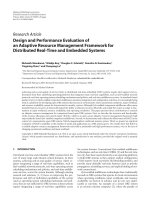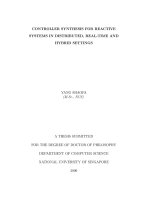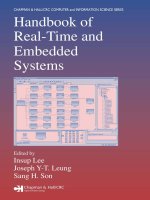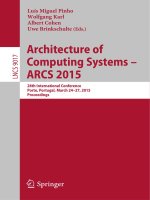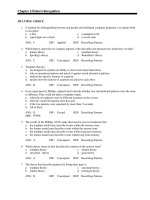Springer real time and embedded computing systems and applications 9th international conference tainan city taiwan ISBN 3540219749 635s ling 2004
Bạn đang xem bản rút gọn của tài liệu. Xem và tải ngay bản đầy đủ của tài liệu tại đây (25.44 MB, 635 trang )
Lecture Notes in Computer Science
Edited by G. Goos, J. Hartmanis, and J. van Leeuwen
2968
Springer
Berlin
Heidelberg
New York
Hong Kong
London
Milan
Paris
Tokyo
Jing Chen Seongsoo Hong (Eds.)
Real-Time and Embedded
Computing Systems
and Applications
9th International Conference, RTCSA 2003
Tainan City, Taiwan, ROC, February 18-20, 2003
Revised Papers
Springer
eBook ISBN:
Print ISBN:
3-540-24686-X
3-540-21974-9
©2005 Springer Science + Business Media, Inc.
Print ©2004 Springer-Verlag
Berlin Heidelberg
All rights reserved
No part of this eBook may be reproduced or transmitted in any form or by any means, electronic,
mechanical, recording, or otherwise, without written consent from the Publisher
Created in the United States of America
Visit Springer's eBookstore at:
and the Springer Global Website Online at:
Preface
This volume contains the 37 papers presented at the 9th International Conference on Real-Time and Embedded Computing Systems and Applications (RTCSA 2003). RTCSA is an international conference organized for scientists and
researchers from both academia and industry to hold intensive discussions on
advancing technologies topics on real-time systems, embedded systems, ubiquitous/pervasive computing, and related topics. RTCSA 2003 was held at the
Department of Electrical Engineering of National Cheng Kung University in
Taiwan. Paper submissions were well distributed over the various aspects of
real-time computing and embedded system technologies. There were more than
100 participants from all over the world.
The papers, including 28 regular papers and 9 short papers are grouped into
the categories of scheduling, networking and communication, embedded systems,
pervasive/ubiquitous computing, systems and architectures, resource management, file systems and databases, performance analysis, and tools and development. The grouping is basically in accordance with the conference program.
Earlier versions of these papers were published in the conference proceedings.
However, some papers in this volume have been modified or improved by the
authors, in various aspects, based on comments and feedback received at the
conference. It is our sincere hope that researchers and developers will benefit
from these papers.
We would like to thank all the authors of the papers for their contribution.
We thank the members of the program committee and the reviewers for their
excellent work in evaluating the submissions. We are also very grateful to all
the members of the organizing committees for their help, guidance and support.
There are many other people who worked hard to make RTCSA 2003 a success.
Without their efforts, the conference and this volume would not have been possible, and we would like to express our sincere gratitude to them. In addition,
we would like to thank the National Science Council (NSC), the Ministry of
Education (MOE), and the Institute of Information Science (IIS) of Academia
Sinica of Taiwan, the Republic of China (ROC) for their generous financial support. We would also like to acknowledge the co-sponsorship by the Information
Processing Society of Japan (IPSJ) and the Korea Information Science Society
(KISS).
Last, but not least, we would like to thank Dr. Farn Wang who helped initiate contact with the editorial board of LNCS to publish this volume. We also
appreciate the great work and the patience of the editors at Springer-Verlag. We
are truly grateful.
Jing Chen and Seongsoo Hong
History and Future of RTCSA
The International Conference on Real-Time and Embedded Computing Systems
and Applications (RTCSA) aims to be a forum on the trends as well as innovations in the growing areas of real-time and embedded systems, and to bring
together researchers and developers from academia and industry for advancing
the technology of real-time computing systems, embedded systems and their
applications. The conference assumes the following goals:
to investigate advances in real-time and embedded systems;
to promote interactions among real-time systems, embedded systems and
their applications;
to evaluate the maturity and directions of real-time and embedded system
technology;
to bridge research and practising experience in the communities of real-time
and embedded systems.
RTCSA started from 1994 with the International Workshop on Real-Time
Computing Systems and Applications held in Korea. It evolved into the International Conference on Real-Time Computing Systems and Applications in 1998.
As embedded systems is becoming one of the most vital areas of research and
development in computer science and engineering, RTCSA changed into the International Conference on Real-Time and Embedded Computing Systems and
Applications in 2003. In addition to embedded systems, RTCSA has expanded
its scope to cover topics on pervasive and ubiquitous computing, home computing, and sensor networks. The proceedings of RTCSA from 1995 to 2000 are
available from IEEE. A brief history of RTCSA is listed below. The next RTCSA
is currently being organized and will take place in Sweden.
1994 to 1997: International Workshop on Real-Time
Computing Systems and Applications
RTCSA 1994 Seoul, Korea
RTCSA 1995 Tokyo, Japan
RTCSA 1996 Seoul, Korea
RTCSA 1997 Taipei, Taiwan
1998 to 2002:
RTCSA 1998
RTCSA 1999
RTCSA 2000
RTCSA 2002
From 2003:
RTCSA 2003
International Conference on Real-Time
Computing Systems and Applications
Hiroshima, Japan
Hong Kong, China
Cheju Island, Korea
Tokyo, Japan
International Conference on Real-Time
and Embedded Computing Systems and
Applications
Tainan, Taiwan
Organization of RTCSA 2003
The 9th International Conference on Real-Time and Embedded Computing Systems and Applications (RTCSA 2003) was organized, in cooperation with the
Information Processing Society of Japan (IPSJ) and the Korea Information
Science Society (KISS), by the Department of Electrical Engineering, National
Cheng Kung University in Taiwan, Republic of China (ROC).
Honorary Chair
Chiang Kao
President of National Cheng Kung University
General Co-chairs
Ruei-Chuan Chang
Tatsuo Nakajima
National Chiao Tung University (Taiwan)
Waseda University (Japan)
Steering Committee
Tei-Wei Kuo
Insup Lee
Jane Liu
Seung-Kyu Park
Heonshik Shin
Kang Shin
Sang H. Son
Kenji Toda
Hideyuki Tokuda
National Taiwan University (Taiwan)
University of Pennsylvania (USA)
Microsoft (USA)
Ajou University (Korea)
Seoul National University (Korea)
University of Michigan at Ann Arbor (USA)
University of Virginia (USA)
ITRI., AIST (Japan)
Keio University (Japan)
Advisory Committee
Alan Burns
Jan-Ming Ho
Aloysius K. Mok
Heonshik Shin
John A. Stankovic
Hideyuki Tokuda
Jhing-Fa Wang
University of York (UK)
IIS, Academia Sinica (Taiwan)
University of Texas, Austin (USA)
Seoul National University (Korea)
University of Virginia (USA)
Keio University (Japan)
National Cheng Kung University (Taiwan)
Publicity Co-chairs
Lucia Lo Bello
Victor C.S. Lee
Daeyoung Kim
Sang H. Son
Kazunori Takashio
University of Catania (Italy)
City University of Hong Kong (Hong Kong)
Information and Communications University (Korea)
University of Virginia (USA)
Keio University (Japan)
VIII
Organization
Program Co-chairs
Jing Chen
Seongsoo Hong
National Cheng Kung University (Taiwan)
Seoul National University (Korea)
Program Committee
Giorgio C. Buttazzo
Jörgen Hansson
Pao-Ann Hsiung
Chin-Wen Hsueh
Dong-In Kang
Daeyoung Kim
Moon Hae Kim
Tae-Hyung Kim
Young-kuk Kim
Lucia Lo Bello
Kam-Yiu Lam
Chang-Gun Lee
Victor C.S. Lee
Yann-Hang Lee
Kwei-Jay Lin
Sang Lyul Min
Tatsuo Nakajima
Yukikazu Nakamoto
Joseph Ng
Nimal Nissanke
Raj Rajkumar
Krithi Ramamritham
Ichiro Satoh
Lui Sha
Wei-Kuan Shih
LihChyun Shu
Sang H. Son
Hiroaki Takada
Yoshito Tobe
Hans Toetenel
Farn Wang
Andy Wellings
Wang Yi
University of Pavia (Italy)
Linkoping University (Sweden)
National Chung Cheng University (Taiwan)
National Chung Cheng University (Taiwan)
ISI East, USC (USA)
Information and Communications University (Korea)
Konkuk University (Korea)
Hanyang University (Korea)
Chungnam National University (Korea)
University of Catania (Italy)
City University of Hong Kong (Hong Kong)
Ohio State University (USA)
City University of Hong Kong (Hong Kong)
Arizona State University (USA)
University of California, Irvine (USA)
Seoul National University (Korea)
Waseda University (Japan)
NEC, Japan (Japan)
Hong Kong Baptist University (Hong Kong)
South Bank University (UK)
Carnegie Mellon University (USA)
India Institute of Technology, Bombay (India)
National Institute of Informatics (Japan)
University of Illinois at Urbana-Champaign (USA)
National Tsing Hua University (Taiwan)
National Cheng Kung University (Taiwan)
University of Virginia (USA)
Toyohashi University of Technology (Japan)
Tokyo Denki University (Japan)
Delft University of Technology (Netherlands)
National Taiwan University (Taiwan)
University of York (UK)
Uppsala University (Sweden)
Reviewers
Lucia Lo Bello
Giorgio C. Buttazzo
Jing Chen
Jörgen Hansson
Seongsoo Hong
Pao-Ann Hsiung
Chih-Wen Hsueh
Dong-In Kang
Daeyoung Kim
Organization
Moon Hae Kim
Tae-Hyung Kim
Young-Kuk Kim
Kam-Yiu Lam
Chang-Gun Lee
Victor C.S. Lee
Yann-Hang Lee
Kwei-Jay Lin
Sang Lyul Min
Tatsuo Nakajima
Yukikazu Nakamoto
Nimal Nissanke
Joseph Ng
Raj Rajkumar
Krithi Ramamritham
Ichiro Satoh
Lui Sha
Wei-Kuan Shih
Lih-Chyun Shu
Sang H. Son
Hiroaki Takada
Yoshito Tobe
Farn Wang
Andy Wellings
Wang Yi
Sponsoring Institutions
National Science Council (NSC), Taiwan, ROC
Ministry of Education (MOE), Taiwan, ROC
Institute of Information Science (IIS) of Academia Sinica, Taiwan, ROC
Information Processing Society of Japan (IPSJ), Japan
Korea Information Science Society (KISS), Korea
IX
This page intentionally left blank
Table of Contents
Scheduling
Scheduling-Aware Real-Time Garbage Collection Using Dual
Aperiodic Servers
Taehyoun Kim, Heonshik Shin
On the Composition of Real-Time Schedulers
Weirong Wang, Aloysius K. Mok
An Approximation Algorithm for Broadcast Scheduling
in Heterogeneous Clusters
Pangfeng Liu, Da-Wei Wang, Yi-Heng Guo
Scheduling Jobs with Multiple Feasible Intervals
Chi-sheng Shih, Jane W.S. Liu, Infan Kuok Cheong
Deterministic and Statistical Deadline Guarantees for a Mixed Set
of Periodic and Aperiodic Tasks
Minsoo Ryu, Seongsoo Hong
Real-Time Disk Scheduling with On-Disk Cache Conscious
Hsung-Pin Chang, Ray-I Chang, Wei-Kuan Shih, Ruei-Chuan Chang
1
18
38
53
72
88
Probabilistic Analysis of Multi-processor Scheduling of Tasks
with Uncertain Parameters
Amare Leulseged, Nimal Nissanke
103
Real-Time Virtual Machines for Avionics Software Porting
and Development
Lui Sha
123
Algorithms for Managing QoS for Real-Time Data Services Using
Imprecise Computation
Mehdi Amirijoo, Jörgen Hansson, Sang H. Son
136
Networking and Communication
On Soft Real-Time Guarantees on Ethernet
Min-gyu Cho, Kang G. Shin
BondingPlus: Real-Time Message Channel in Linux Ethernet
Environment Using Regular Switching Hub
Hsin-hung Lin, Chih-wen Hsueh, Guo-Chiuan Huang
158
176
XII
Table of Contents
An Efficient Switch Design for Scheduling Real-Time
Multicast Traffic
Deming Liu, Yann-Hang Lee
194
Embedded Systems/Environments
XRTJ: An Extensible Distributed High-Integrity Real-Time
Java Environment
Erik Yu-Shing Hu, Andy Wellings, Guillem Bernat
208
Quasi-Dynamic Scheduling for the Synthesis of Real-Time Embedded
Software with Local and Global Deadlines
Pao-Ann Hsiung, Cheng-Yi Lin, Trong-Yen Lee
229
Frame work-Based Development of Embedded Real-Time Systems
Hui-Ming Su and Jing Chen
Hui-Ming Su, Jing Chen
244
OVL Assert ion-Checking of Embedded Software with
Dense-Time Semantics
Farn Wang, Fang Yu
254
Pervasive/Ubiquitous Computing
System Support for Distributed Augmented Reality in Ubiquitous
Computing Environments
Makoto Kurahashi, Andrej van der Zee, Eiji Tokunaga,
Masahiro Nemoto, Tatsuo Nakajima
279
Zero-Stop Authentication: Sensor-Based Real-Time
Authentication System
Kenta Matsumiya, Soko Aoki, Masana Murase, Hideyuki Tokuda
296
An Interface-Based Naming System for Ubiquitous
Internet Applications
Masateru Minami, Hiroyuki Morikawa, Tomonori Aoyama
312
Systems and Architectures
Schedulability Analysis in EDF Scheduler with Cache Memories
A. Martí Campoy, S. Sáez, A. Perles, J. V. Busquets
Impact of Operating System on Real-Time Main-Memory Database
System’s Performance
Jan Lindström, Tiina Niklander, Kimmo Raatikainen
The Design of a QoS-Aware MPEG-4 Video System
Joseph Kee-Yin Ng, Calvin Kin-Cheung Hui
328
342
351
Table of Contents
XIII
Resource Management
Constrained Energy Allocation for Mixed Hard and Soft
Real-Time Tasks
Yoonmee Doh, Daeyoung Kim, Yann-Hang Lee, C.M.Krishna
371
An Energy-Efficient Route Maintenance Scheme for Ad Hoc
Networking Systems
DongXiu Ou, Kam-Yiu Lam, DeCun Dong
389
Resource Reservation and Enforcement for Framebuffer-Based Devices
Chung-You Wei, Jen-Wei Hsieh, Tei-Wei Kuo, I-Hsiang Lee,
Yian-Nien Wu, Mei-Chin Tsai
398
File Systems and Databases
An Efficient B-Tree Layer for Flash-Memory Storage Systems
Chin-Hsien Wu, Li-Pin Chang, Tei-Wei Kuo
409
Multi-disk Scheduling for High-Performance RAID-0 Devices
Hsi-Wu Lo, Tei-Wei Kuo, Kam-Yiu Lam
431
Database Pointers: A Predictable Way of Manipulating Hot Data
in Hard Real-Time Systems
Dag Nyström,
Christer Norström,
Jörgen Hansson
454
Performance Analysis
Extracting Temporal Properties from Real-Time Systems by
Automatic Tracing Analysis
Andrés Terrasa, Guillem Bernat
Rigorous Modeling of Disk Performance for Real-Time Applications
Sangsoo Park, Heonshik Shin
Bounding the Execution Times of DMA I/O Tasks on Hard-Real-Time
Embedded Systems
Tai-Yi Huang, Chih-Chieh Chou, Po-Yuan Chen
466
486
499
Tools and Development
Introducing Temporal Analyzability Late in the Lifecycle of
Complex Real-Time Systems
Anders Wall, Johan Andersson, Jonas Neander, Christer Norström,
Martin Lembke
RESS: Real-Time Embedded Software Synthesis and
Prototyping Methodology
Trong-Yen Lee, Pao-Ann Hsiung, I-Mu Wu, Feng-Shi Su
513
529
XIV
Table of Contents
Software Platform for Embedded Software Development
Win-Bin See, Pao-Ann Hsiung, Trong- Yen Lee, Sao-Jie Chen
Towards Aspectual Component-Based Development of
Real-Time Systems
Dag Nyström, Jörgen Hansson,
Christer Norström
545
558
Testing of Multi-Tasking Real-Time Systems with Critical Sections
Anders Pettersson, Henrik Thane
578
Symbolic Simulation of Real-Time Concurrent Systems
Farn Wang, Geng-Dian Huang, Fang Yu
595
Author Index
619
Scheduling-Aware Real-Time Garbage Collection
Using Dual Aperiodic Servers
Taehyoun Kim1 and Heonshik Shin2
1
SOC Division, GCT Research, Inc.,
Seoul 150-877, Korea
2
School of Electrical Engineering and Computer Science, Seoul National University,
Seoul 151-742, Korea
Abstract. Garbage collection has not been widely used in embedded real-time
applications since traditional real-time garbage collection algorithm can hardly
bound its worst-case responsiveness. To overcome this limitation, we have proposed a scheduling-integrated real-time garbage collection algorithm based on
the single aperiodic server in our previous work. This paper introduces a new
scheduling-aware real-time garbage collection which employs two aperiodic
servers for garbage collection work. Our study aims at achieving similar performance compared with the single server approach whilst relaxing the limitation
of the single server approach. In our scheme, garbage collection requests are
scheduled using the preset CPU bandwidth of aperiodic server such as the sporadic server and the deferrable server. In the dual server scheme, most garbage
collection work is serviced by the secondary server at low priority level. The
effectiveness of our approach is verified by analytic results and extensive simulation based on the trace-driven data. Performance analysis demonstrates that the
dual server scheme shows similar performance compared with the single server
approach while it allows flexible system design.
1 Introduction
As modern programs require more functionality and complex data structures, there is a
growing need for dynamic memory management on heap to efficiently utilize the memory
by recycling unused heap memory space. In doing so, dynamic memory may be managed
explicitly by the programmer through the invocation of “malloc/free” procedures which
is often error-prone and cumbersome.
For this reason, the system may be responsible for the dynamic memory reclamation
to achieve better productivity, robustness, and program integrity. Central to this automatic memory reclamation is the garbage collection (GC) process. The garbage collector
identifies the data items that will never be used again and then recycles their space for
reuse at the system level.
In spite of its advantages, GC has not been widely used in embedded real-time
applications. This is partly because GC may cause the response time of application
to be unpredictable. To guarantee timely execution of a real-time application, all the
J. Chen and S. Hong (Eds.): RTCSA 2003, LNCS 2968, pp. 1–17, 2004.
© Springer-Verlag Berlin Heidelberg 2004
2
T. Kim and H. Shin
components of the application must be predictable. A certain software component is
predictable means that its worst-case behavior is bounded and known a priori.
This is because garbage collectors should also run in real-time mode for predictable
execution of real-time applications. Thus, the requirements for real-time garbage collector are summarized and extended as follows [1]; First, a real-time garbage collector
often interleaves its execution with the execution of an application in order to avoid intolerable pauses incurred by the stop-and-go reclamation. Second, a real-time collector
must have mutators 1 report on any changes that they have made to the liveness of heap
objects to preserve the consistency of a heap. Third, garbage collector must not interfere
with the schedulability of hard real-time mutators. For this purpose, we need to keep
the basic memory operations short and bounded. So is the synchronization overhead
between garbage collector and mutators. Lastly, real-time systems with garbage collection must meet the deadlines of hard real-time mutators while preventing the application
from running out of memory.
Considering the properties that are needed for real-time garbage collector, this paper presents a new scheduling-aware real-time garbage collection algorithm. We have
already proposed a scheduling-aware real-time GC scheme based on the single server
approach in [ 1 ]. Our GC scheme aims at guaranteeing the schedulability of hard real-time
tasks while minimizing the system memory requirement. In the single server approach,
an aperiodic server services GC requests at the highest priority level. It has been proved
that, in terms of memory requirement, our approach shows the best performance compared with other aperiodic scheduling policies without missing hard deadlines [1].
However, the single server approach has a drawback. In terms of rate monotonic
(RM) scheduling, the server must have the shortest period in order to be assigned for
the highest priority. Usually, the safe server capacity for the shortest period may not
be large enough to service a small part of GC work. For this reason, the single server
approach may be sometimes impractical. To overcome this limitation, we propose a
new scheduling-aware real-time GC scheme based on dual aperiodic servers. In the dual
server approach, GC requests are serviced in two steps. The primary server atomically
processes the initial steps such as flipping and memory initialization at the highest priority
level. The secondary server scans and evacuates live objects. The effectiveness of the
new approach is verified by simulation studies.
The rest of this paper is organized as follows. Sect. 2 presents a system model and
formulates the problem addressed in this paper. The real-time GC technique based on the
dual aperiodic servers is introduced in Sect. 3. Performance evaluation for the proposed
schemes is presented in Sect. 4. This section proves the effectiveness of our algorithm by
estimating various memory-related performance metrics. Sect. 5 concludes the paper.
2 Problem Statement
We now consider a real-time system with a set of periodic priority-ordered mutator
tasks,
where
is the lowest-priority task and all the tasks
follow rate monotonic scheduling [2]. The task model in this paper includes an additional
1
Because tasks may mutate the reachability of heap data structure during the GC cycle, this
paper uses the term “mutator” for the tasks that manipulate dynamically-allocated heap.
Scheduling-Aware Real-Time Garbage Collection Using Dual Aperiodic Servers
3
property, memory allocation requirement of
is characterized by a tuple
(see Table 1 for notations). Our discussion will be based on the following
assumptions:
Assumption 1: There are no aperiodic mutator tasks.
Assumption 2: The context switching and task scheduling overhead are negligibly
small.
Assumption 3: There are no precedence relations among
The precedence constraint placed by many real-time systems can be easily removed by partitioning tasks
into sub-tasks or properly assigning the priorities of tasks.
Assumption 4: Any task can be instantly preempted by a higher priority task, i.e.,
there is no blocking factor.
Assumption 5:
and
are known a priori.
Although estimation of is generally an application-specific problem,
can be specified by the programmer or can be given by a pre-runtime trace-driven analysis [3]. The
target system is designed to adopt dynamic memory allocation with no virtual memory.
In this paper, we consider a real-time copying collector proposed in [3], [4] for its simplicity and real-time property. This paper treats each GC request as a separate aperiodic
task
where and denote the release time and completion time
of the
GC request
respectively.
In our memory model, the cumulative memory consumption
by a
mutator task, defined for the interval
is a monotonic increasing function.
Although the memory consumption function for each mutator can be various types
of functions, we can easily derive the upper bound of memory consumption of
during time units from the worst-case memory requirement of
which amounts to
a product of
and the worst-case invocation number of
during time units. Then,
4
T. Kim and H. Shin
the cumulative memory consumption by all the mutator tasks at
bounded by the following equation.
is
On the contrary, the amount of available memory depends on the reclamation rate of
the garbage collector. For the copying collector, half of the total memory is reclaimed
entirely at flip time. Actually, the amount of heap memory reproduced by
depends
on M and the size of live objects
and is bounded by
We now consider the property of real-time GC request
First,
is an aperiodic
request because its release time is not known a priori. It is released when the cumulative memory consumption exceeds the amount of free (recycled) memory. Second,
is a hard real-time request. The
GC request
must be completed before
is released. In other words, the condition
should always
hold. Suppose that available memory becomes less than a certain threshold while previous GC request has not been completed yet. In this case, the heap memory is fully
occupied by the evacuated objects and newly allocated objects. Thus, neither the garbage
collector nor mutators can continue to execute any longer.
On the other hand, the system may also break down if there is no CPU bandwidth
left for GC at
even though the condition
holds. To solve this problem,
we propose that the system should reserve a certain amount of memory spaces in order
to prevent system break-down due to memory shortage. We also define a reservation
interval, denoted by
to bound the memory reservation. The reservation interval
represents the worst-case time interval
where
is the earliest time
instant at which the CPU bandwidth for GC becomes available. Hence, the amount of
memory reservation
can be computed by the product of
and the memory
requirement of all the mutator tasks during
There should also be memory spaces in
which currently live objects are copied. As a result, for the copying collector addressed
in this paper, the system memory requirement is given by:
where
and
denote the worst-case memory reservation and the worst-case live
memory, respectively. The reservation interval
is derived from the worst-case GC
response time
and the GC scheduling policy.
3 Dual Server Approach
3.1 Background
We have presented a scheduling-aware garbage collection scheme using single aperiodic
server in [1], [3]. In the single server approach, GC work is serviced by an aperiodic server
with a preset CPU bandwidth at the highest priority. The aperiodic server preserves its
bandwidth waiting for the arrival of aperiodic GC requests. Once a GC request arrives in
Scheduling-Aware Real-Time Garbage Collection Using Dual Aperiodic Servers
5
the meantime, the server performs GC as long as the server capacity permits; if it cannot
finish within one server period, it will resume execution when the consumed execution
time for the server is replenished. By assigning the highest priority, the garbage collector
can start immediately on arriving
preempting the mutator task running.
However, the single server approach has a drawback. Under the aperiodic server
scheme, the server capacity tends to be very small at the highest priority. Although the
server capacity may be large enough to perform the initial parts of GC procedure such as
flipping and memory initialization, it may not be large enough to perform single copying
operation of a large memory block. Guaranteeing the atomicity of such operation may
yield another unpredictable delay such as synchronization overhead. For this reason, this
approach may be sometimes impractical.
3.2 Scheduling Algorithm
In this section, we present a new scheduling-aware real-time GC scheme based on dual
aperiodic servers. In the dual server approach, GC is performed in two steps. The primary
server performs flip operation and atomic memory initialization at the highest priority.
The secondary server incrementally traverses and evacuates live objects. The major
issue of dual server approach is to decide the priority of the secondary server and its safe
capacity. We mean maximum server capacity which can guarantee the schedulability of
given task set by safe capacity. The dual server approach can be applied to the sporadic
server (SS) and the deferrable server (DS).
The first step is to find the safe capacity of the secondary server. This procedure
is applied to each priority level of periodic tasks in given task set for simplicity. In
doing so, we assume that the priority of the secondary server is assigned according
to the RM policy. There is always a task of which period is identical to the period of
the secondary server because we compute the capacity of the secondary server for the
periods of periodic tasks. In this case, the priority of secondary server is always higher
than that of such a task.
The maximum idle time at priority level denoted by
is set to the initial value
of the capacity. For each possible capacity of the secondary server
we
can find the maximum capacity at priority level which can guarantee the schedulability
of given task set using binary search. As a result, we have alternatives for the parameters
of the secondary server. The selection of the parameter is dependent on the primary
consideration of system designer. In general, the primary goal is to achieve maximum
server utilization. However, our goal is to minimize the memory requirement as long as
there exists a feasible schedule for hard real-time mutators.
As mentioned in Sect. 2, the system memory requirement is derived from
and
The worst-case memory reservation is derived from
under the scheduling
policy used. Hence, we need a new algorithm to find
under the dual server approach
to derive the memory requirement.
For this purpose, we use the schedulability analysis which is originally presented by
Bernat [5]. Let the pair of parameters (period, capacity) =
of the primary server
and the secondary server be
and
respectively. Then, we assign
and
such that is the smallest time required for flipping and atomic
6
T. Kim and H. Shin
Fig. 1. Response time of
memory initialization. Traditional worst-case response time formulation can be used to
compute
In Theorem 1, we show the worst-case response time of GC under the SS policy.
Theorem 1. Under the SS, for fixed
and
the response time of
the garbage collector
of the dual server approach is bounded by the
completion
time of a virtual server task
with
period,
capacity, and
offset such that
is the worst-case response time of a task
which
is the lowest priority task among the higher priority tasks than the secondary server,
and
Proof. Let
be the available capacity of the secondary server when a new GC
request is released. If the condition
is satisfied, then the GC request
is completely serviced within one period of the secondary server. Otherwise, additional
server periods are required to complete
The remaining GC work must be processed
after the capacity of the secondary server is replenished. We assume that there is always
capacity available when a new GC request arrives. This is because the replenishment
period of the primary server will always be shorter than or equal to that of the secondary
server. If this assumption is not valid, GC requests will always fail.
The interval, say
between the beginning of
and the first replenishment of the
secondary server is at most
In other words, the first period of the secondary
server is released time units after was requested because the secondary server may
not be released immediately due to interference caused by higher priority tasks. In the
proof of Theorem 1,
is computed by using the capacity of the sporadic server and
the replenishment period.
Roughly, the worst-case response time of coincides with the
completion time
of the secondary server with
offset such that
More correctly,
Scheduling-Aware Real-Time Garbage Collection Using Dual Aperiodic Servers
7
it is the sum of
any additional server periods required for replenishment, and the
CPU demand remaining at the end of GC cycle. It results from the assumption that
all the mutator tasks arrive exactly at which the first replenishment of the secondary
server occurs. In this case, the second replenishment of the secondary server occurs at
the time when all the higher priority tasks have been completed. Formally, in the worstcase, the longest replenishment period of the secondary server is equal to the worst-case
response time of
denoted by
where
is the lowest priority task among the
higher priority tasks. Because the interference is always smaller than the worst-case
interference at the critical instant, the following replenishment periods are always less
than or equal to the first replenishment period. Hence, we can safely set the period of
a virtual task
to
The CPU demand remaining at the end of GC cycle,
say is given by:
It follows that the sum of the server periods required and the CPU demand remaining
at the end of GC cycle actually corresponds to the worst-case response time of the
response time of a virtual server task
with
period and capacity. Because
a task’s response time is only affected by higher priority tasks, this conversion is safe
without loss of generality. Fig. 1 illustrates the worst-case situation.
Since the DS has different server capacity replenishment policy, we have the following theorem.
Theorem 2. Under the DS, for fixed
and
the response time of
the garbage collector
of the dual server approach is bounded by the
completion
time of a virtual server task
with
period,
capacity, and
offset such that
and
Proof. The server capacity for the DS is fully replenished at the beginning of server’s
period while the SS replenishes the server capacity exactly
time units after the aperiodic request was released. For this reason, the period of a virtual task
equals
For the dual server approach, we do not need to consider the replenishment of server
capacity in computing
This is because there is always sufficiently large time
interval to replenish the capacity of the primary server between two consecutive GC
cycles. Finally we have:
Let
denote the
completion time of a virtual secondary server task
As shown above,
is equal to
To derive the memory requirement, we now
8
T. Kim and H. Shin
present how we can find
with given parameters of the secondary server. We
now apply Bernat’s analysis to find
Bernat presents an extended formulation to
compute the worst-case completion time of
at its
invocation.
We explain briefly the extended worst-case response time formulation. Let us first
consider the worst-case completion time of
at the second invocation. The completion
time of the second invocation
includes its execution time and interference caused by
higher priority tasks. The interference is always smaller than the worst-case interference
at the critical instant. Formally, the idle time at priority level at
denoted by
is defined as the amount of CPU time can be used by tasks with lower priority than
during the period [0,
in [5]. Again, the amount of idle time at the start of each task
invocation is written as:
Based on the above definitions,
includes the time required to complete two invocations of
the CPU time used by lower priority tasks
idle time), and the
interference due to higher priority tasks. Thus, it is given by the following recurrence
relation:
where
denotes the interference caused by tasks with higher priority than task
The correctness of Eq. (4) is proved in [5].
Similarly, the completion time of the
invocation of
is the sum of the
time required to complete invocations of
the CPU time used by lower priority
tasks, and the interference due to higher priority tasks. Thus, we have
as the
smallest
such that:
More formally,
relation:
corresponds to the smallest solution to the following recurrence
As mentioned earlier, the worst-case response time of garbage collector equals
Following the definition of
it can be found by the worst-case response
time analysis at the critical instant. For this reason, we can apply the Bernat’s extended
worst-case response time formulation to our approach without loss of generality.
is the smallest solution
where
to the following recurrence
relation:
Scheduling-Aware Real-Time Garbage Collection Using Dual Aperiodic Servers
9
where
and
In Eq. (7),
and
can be easily computed because
is known a priori. Hence, we need
only to compute
in order to compute
To compute
we assume another virtual task
as follows:
At the beginning of this section, we compute the safe capacity of the secondary server
at priority level by computing
Similarly, the amount of idle time between
[0,
which has been unused by the tasks with priorities higher than or equal to
corresponds to the upper bound for the execution time of the virtual task
Then,
is computed by obtaining the maximum which can guarantee that the virtual
task
is schedulable. Formally, we have:
The maximum
and
which satisfies the condition in Eq. (8) is the solution
to the following equation:
where
where
denotes the interference caused by the tasks with higher than or equal
priority to task A simple way of finding is to perform binary search for the interval
[0,
of which complexity is
Actually, this approach may be somewhat
expensive because, for each value
the worst-case response time formulation
must be done for higher priority tasks. To avoid this complexity, Bernat also presents an
effective way of computing
by finding more tighter bounds. However, his approach
is not so cost-effective for our case which targets at finding a specific
We present a simple approach to reduce the test space. It is possible by using the fact
that is actually the idle time unused by the tasks with higher than or equal to priorities
than the secondary server. Using the definition of
the interference of tasks with
higher than or equal priority to
the upper bound for is given by:
where
denotes the set of tasks with higher than or equal priority to the secondary server.
The lower bound for can also be tightened as follows. Given any time interval
the worst-case number of instances of
within the interval can approximate
We can optimize this trivial bound using the analysis in [3]. The analysis
10
T. Kim and H. Shin
uses the worst-case response time of
It classifies the instances into three cases
according to their invocation time. As a result of analysis, it follows that the number of
instances of
within a given time interval denoted by
is given by:
For details, refer to [3].
The above formulation can be directly applied to finding the lower bound for
by substituting for
Finally, we have:
3.3 Live Memory Analysis
We have proposed a three-step approach to find the worst-case live memory for the
single server approach in [4]. According to the live memory analysis, the worst-case live
memory
equals the sum of the worst-case global live memory
and the worstcase local live memory
Usually, the amount of global live objects is relatively
stable throughout the execution of application because global objects are significantly
longer-lived than local objects. On the other hand, the amount of local live objects
continues to vary until the time at which the garbage collector is triggered. For this
reason, we concentrate on the analysis of the worst-case local live memory.
The amount of live objects for each task depends not on the heap size but on the state
of each task. Although the amount of live memory is a function of
and varies during
the execution of a task instance, it is stabilized at the end of the instance. Therefore, we
find the worst-case live local memory by classifying the task instances into two classes:
active and inactive2. Accordingly, we set the amount of live memory for an active task
to in order to cover an arbitrary live memory distribution. By contrast, the amount
of live memory for an inactive task
converges
where denotes the stable live
factor out of
Consequently, the worst-case live local live memory is bounded by:
where
and
denote the set of active tasks and the set of inactive
tasks at time respectively. We also assume the amount of global live memory to be a
constant
because it is known to be relatively stable throughout the execution of
the application. Then,
equals the sum of
and
We now modify the live memory analysis slightly to cover the dual server approach.
We first summarize the three-step approach as follows:
2
We regard a task as active if the task is running or preempted by higher priority tasks at time
instant Otherwise, the task is regarded as inactive.


